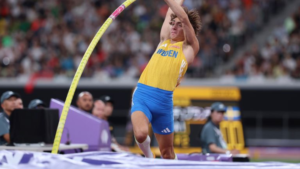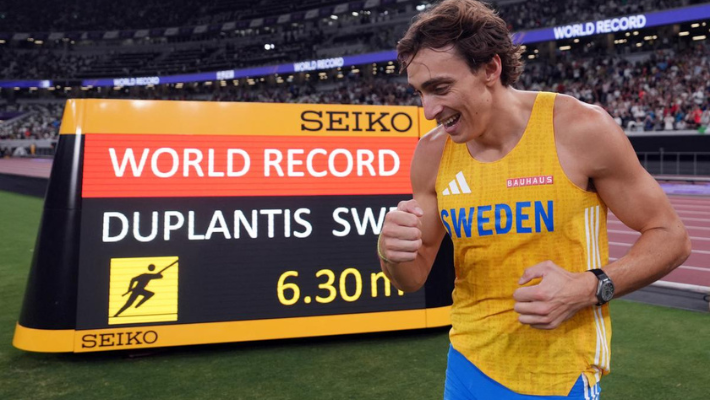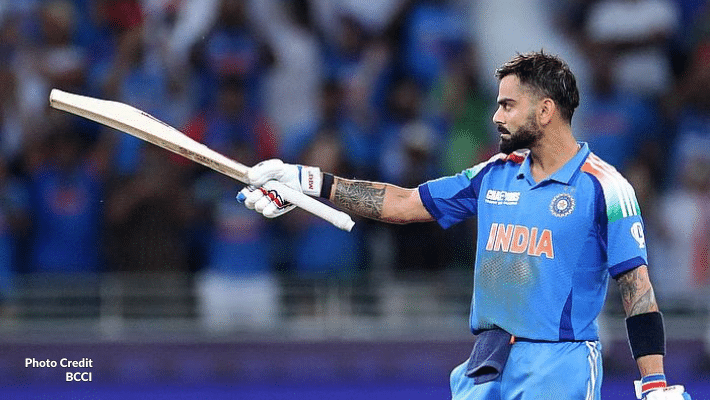Armand Duplantis Shatters 6.30m in Tokyo: 14th World Record Caps Pole Vault Mastery
Sweden’s Armand “Mondo” Duplantis clears 6.30 m to win gold at the 2025 World Athletics Championships in Tokyo, claiming his third consecutive world title while redefining what’s possible in pole vault.
Armand Duplantis broke his own pole vault world record for the 14th time, clearing 6.30 m to win gold at the 2025 World Athletics Championships in Tokyo
On September 15, 2025, at the World Athletics Championships in Tokyo, Armand “Mondo” Duplantis of Sweden delivered yet another astonishing feat. Having already secured gold, he raised the bar to 6.30 metres, clearing it on his third attempt to break his own world record—his 14th overall. This performance not only reinforces his dominance in pole vaulting but pushes the boundaries of what many thought possible. In this analysis, we explore how he did it, who he beat, what this means technically, mentally, and historically, and where pole vaulting may go next.
Armand Duplantis broke his own pole vault world record for the 14th time, clearing 6.30 m to win gold at the 2025 World Athletics Championships in Tokyo. This article explores his performance, technical mastery, competition, mental resilience, and what it means for the sport’s future.
The Performance: What Happened
- Duplantis took gold with strong clearances through the competition, distancing himself from rivals early. He cleared heights including 5.95 m, 6.00 m, 6.10 m, and 6.15 m, often on first attempts, putting pressure on his competition.
- With gold assured, the big moment came: the bar raised to 6.30 m, 1 cm above his previous world record of 6.29 m. He missed his first two attempts, with the second being agonizingly close (the bar wobbled before falling). On his third and final attempt, he executed with near perfection and cleared 6.30 m.
- Emmanouil Karalis of Greece took silver with a best of 6.00 m, and Kurtis Marschall of Australia won bronze, clearing 5.95 m (on countback) ahead of Sam Kendricks.
- The crowd at Japan’s National Stadium erupted—this time, spectators were present, in contrast to some past events (including Tokyo Olympics held under COVID restrictions). The atmosphere, Duplantis himself said, was “motivational.”

(Photo Credit: Sky sports)
Technical & Mental Components
- Incremental record-raising strategy: Duplantis has repeatedly broken his world records in small gains—often just 1 centimeter above previous marks. This reflects both confidence and precision in training, technique, equipment and mental readiness.
- Equipment & conditions: Pole selection, runway speed, and environmental factors matter. There are references to “the Claw” (special shoes for speed/plant-phase effectiveness) in some reports. While not always used, such specialized gear can make a difference in critical moments.
- Mental resilience under pressure: Missing first two attempts at 6.30 m would crumple many, but Duplantis held composure on his third – nerves, technique and focus aligned. His experience in big meets evidently aids in this composure.
- Competition context: Rivals pushed him to maintain near-perfect execution, but none could match final heights. Setting the bar slightly higher after gold was assured is both symbolic and practical: it raises the bar (literally) for the sport.
Historical Context & Significance
- This is his third consecutive world title in pole vault (2022, 2023, 2025).
- He has now broken the world pole vault record 14 times since first surpassing Renaud Lavillenie’s mark. Incremental improvements have become signature.
- Clearing 6.30 m places him among the very few athletes to vault beyond 6.20 m with regularity; his consistency and ability to raise records in big championships distinguish him.
Competition & Rivals
| Athlete | Best Cleared in Tokyo Final | Key Strengths | What They Need to Close the Gap |
|---|---|---|---|
| Armand Duplantis (Sweden) | 6.30 m (WR) | Unmatched consistency; capacity to raise record once gold is secured; high technical skill; mental toughness under pressure | Marginal gains: bar stability, fine tuning equipment; managing peaks and injury risk as he pushes limits |
| Emmanouil Karalis (Greece) | 6.00 m | Strong competitor; second place shows capacity; may have fewer failures; rising athlete | Need to increase clearance heights; more attempts; consistency at heights above 6.10-6.20 m; technical refinement |
| Kurtis Marschall (Australia) | 5.95 m | Personal best equalled; good under pressure; podium experience | Break into 6.00 m+ territory more often; reduce misses; build strong competition experience at major meets |
Comparison Chart: Duplantis vs Other Athletes & Sports Icons
To give perspective, here’s a comparative chart that frames Duplantis’s achievement alongside other legends or benchmark athletes, using analogies with figures from other sports to illustrate dominance, innovation, consistency:
| Metric | Duplantis | Usain Bolt (Sprint) | Michael Phelps (Swimming) | Simone Biles (Gymnastics) |
|---|---|---|---|---|
| Dominance in Event | 14 world records, multiple world championships, Olympic gold | 8 Olympic golds, multiple WRs; domination in 100m/200m globally | Record medal counts; dominant across many events over long period | Most decorated gymnast; high difficulty routines; sets standard beyond peers |
| Incremental Improvement | Raises WR by small margins; maintains consistency | Burst improvements when world records fell rarely after 2008-2012 | Breaking WRs by small, often hundredths of a second; consistency across strokes | Pushing difficulty, perfecting execution; evolving routines |
| Mental Performance under Pressure | Known to deliver in finals under massive pressure (Worlds, Olympics) | Famous for performing best in finals – e.g. 2008, 2009, 2012 | Olympic finals, relay pressure; expectation heavy | Big stage performance; comeback mental strength |
| Longevity / Peak Period | Still young (~25), though pushing peak limits; already many records | Retired earlier than long era; sprinting has shorter career span | Having competed over many Olympic cycles; long elite career | Similar – injuries but absolute dominance maintained over years |
What It Means for Pole Vault & Athletics
- Duplantis continuing to raise standards pushes rivals to innovate, train harder, and perhaps revisit equipment, technique, biomechanics.
- The small-increment record improvements reflect both how mature the event is (we are approaching human / material limits) and how marginal gains become decisive.
- The visibility: a roaring crowd in Tokyo, record after record, adds to athletics’ appeal. It may inspire young athletes globally to take up vaulting.
- Potential next targets: can Duplantis push toward 6.40 m? Or will external factors (injuries, weather, equipment) limit future gains? Also, how he maintains consistency in major meets will be much watched.
Conclusion
Armand Duplantis’s performance in Tokyo is more than just yet another world record. It represents a confluence of technical precision, mental fortitude, and athletic consistency. Clearing 6.30 m for the 14th time, under pressure, in front of a live audience, solidifies his status not just as the best pole vaulter of his generation, but among the greatest of all time in athletics.
His rivals remain strong, but for now, Duplantis has redefined what the bar means—literally and metaphorically. As the sport looks ahead, one question remains: how far, and how high, can he take it next?




